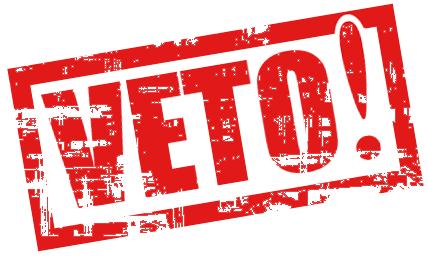Veto Override Procedure in the House and Senate
Summary
A bill or joint resolution that has been vetoed by the President can become law if two-thirds of the Members voting in the House and the Senate each agree to pass it over the President’s objection. The chambers act sequentially on vetoed measures; the House acts first on House-originated measures (H.R. and H.J. Res.) and the Senate acts first on Senate-originated measures (S. and S.J. Res.). If the first-acting chamber fails to override the veto, the measure dies and the other chamber does not consider it. The House typically considers the question of overriding a presidential veto under the hour rule, with time customarily controlled and allocated by the chair and ranking member of the committee with jurisdiction over the bill. The Senate usually considers the question of overriding a veto under the terms of a unanimous consent agreement.
Voting in the House
To override a veto, two-thirds of the Members voting, a quorum being present, must agree to repass the bill over the President’s objections. The Constitution requires that the vote be by the “yeas and nays,” which in the modern House means that Members’ votes will be recorded through the electronic voting system. The vote on the veto override is final because, in contrast to votes on most other questions in the House, a motion to reconsider the vote on the question of overriding a veto is not in order.
Full rules below…
~
4closureFraud.org
~
H.R. 3808 Veto Override Procedure in the House and Senate


WE TEACH OUR CHILREN TO BE GOD-FEARING, DO NOT LIE, BE HONEST, TO RESPECT THE LAW, AND OUR PRESIDENT… TO WORK HARD, GO TOSCHOOL AND YOU WILL HAVE A HOME AND CHILDREN . WE ACTUALLY BELIEVED WE HAD PROTECTION FROM THE CROOKS AND THEY ARE ALL CROOKS! WHO DO WE TEACH OUR CHILDREN TO PROTECT THEM FROM HARM? THANK GOD FOR YOU ATTORNIES AND FORECLOSURE FRAUD, HAMLET,…GOD BLESS YOU ALL. WITHOUT YOU AND GOD ABOVE WE WOULD HAVE LOST. WE ARENOT GOING TO LOSE THIS BATTLE EVEN IF WE ALL HAVETO MARCH TOGETHER!! RIGHT NOW I AMON MY KNEES PRAYING FOR HR3808 DIES IN CONGRESS.
Find info here .
http://www.house.gov/
Found this , looks like tomorrow its coming up in the house .Call your representative in their Washington office, and voice your opposition to over ride the presidents veto on HR 3808 . Tell them that it will be aiding and abetting the fraudulent documents that are in the news now: “Robosigners”, Foreclosure Mills , ECT .
10/8/2010:
Vetoed by President.
11/15/2010 2:14pm:
” VETO MESSAGE FROM THE PRESIDENT – The Chair laid before the House the veto message from the President on H.R. 3808. The objections of the President were spread at large upon the Journal, and the veto message was ordered to be printed as a House Document No. 111-152. Pursuant to the order of the House of earlier today, further consideration of the veto message and the bill are postponed until the legislative day of Wednesday, Nov. 17, 2010, and that on that legislative day, the House shall proceed to the constitutional question of reconsideration and dispose of such question without intervening motion. ”
Tell them to bury this attempt to legalize their fraudulent docs .
Isn’t it time we all woke up to the fact that nobodys for us home owners except us,thier out to take us down one way or the other.It doesnt much matter who you are or where you come from how much money you have or don’t have,the end result is the same.They make thier ill gotten gains off the backs of people like us and the one’s coming up behind us.They will stoop to any levels to bring about the procurement of thier illict gains.It is time to get serious and throw more than a tea party.Come on America and wake up!
could the banks be holding off on the judicial foreclosures awaiting passage of HR3808 – as if they know it’s gonna happen anyway… so it’s not that they are combing their records. they’re thinking the robosigning and affadavit issues will be cleansed of their sins
Michael,
There is a lot of scary s**t floating around these days. Are you suggesting there is a move afoot to over ride the veto of HR 3808?
Inquiring minds want to know. Or at least this one does.
Trying to figure that out.
Wouldn’t Secretary of State Brunner know what this all means? We all need to know the truth. They are all so sneaky in that Congress. We just cannot trust these people. The people do not need another thing to worry about or legislation floating around that could be passed under all of our noses. These people in Congress who are doing this to all of us need to be indicted and need to go to prison, too. They are all accomplices to the crime.
How do we stop it this time? Its really hard for me to believe that Dems want to throw us under the bus too. I can understand the repugs doing it – they hate the middle class and I know that, but the Dems pretend to be all for the little people. Ha!
Ok, sent e-mails.
This is legislation WITHOUT representation.
If they (the unanimous voice vote) were so “proud” of this bill they tried to rush through then WHY didn’t they have the COURAGE to put their NAMES to it?
SHOWS YOU HOW QUICKLY SOMETHING CAN REALLY BE PUSHED THRU DOESNT IT WHEN IT BENEFITS THE CROOKED